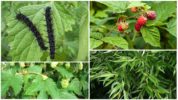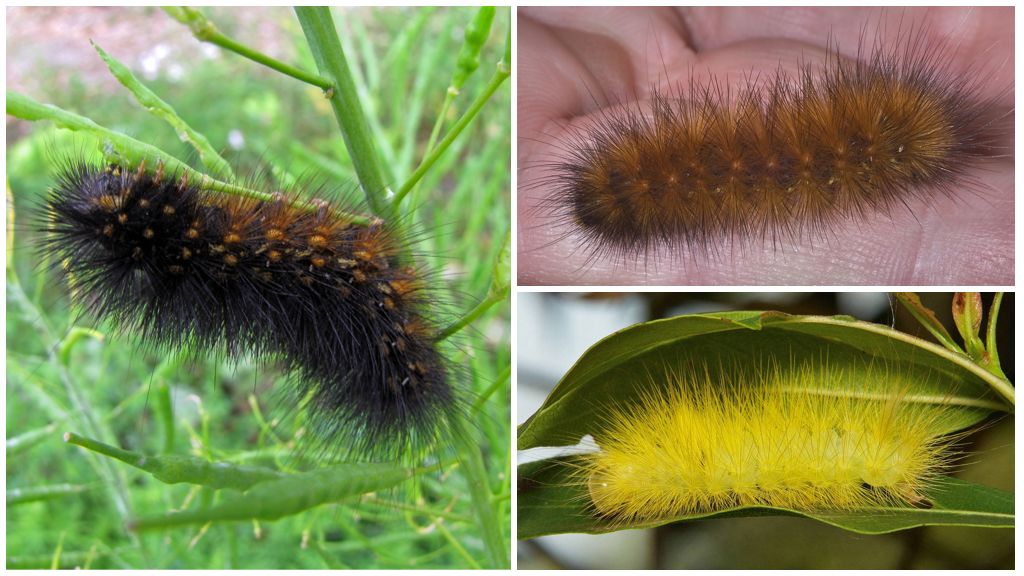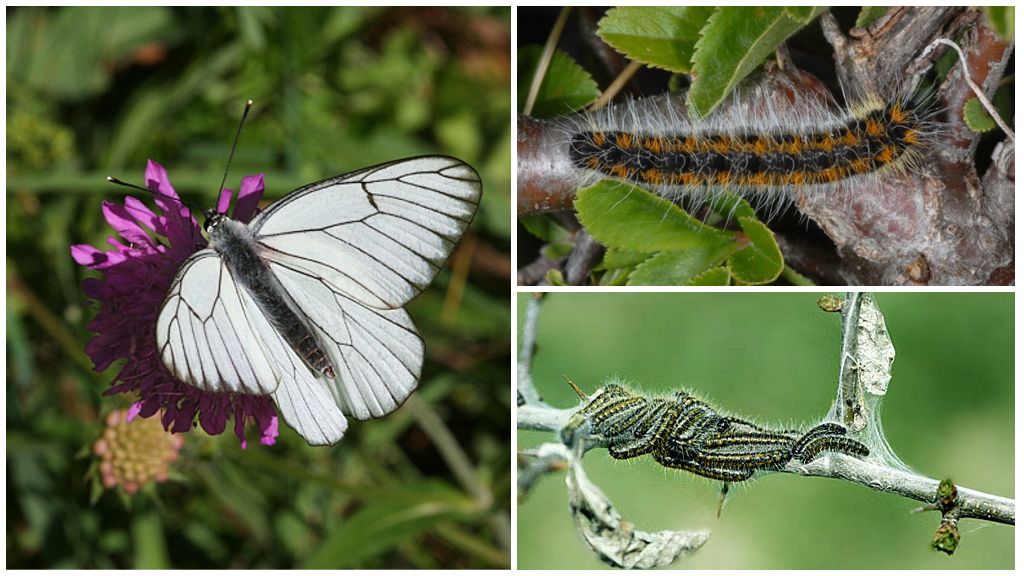- Peacock-Eye Caterpillars
- Peacock Eye Caterpillar Nutrition
- Peacock-eye pear and its caterpillars
Butterfly peacock eye - one of the most beautiful on the planet. The moth belongs to the nifalid family. It is distributed almost everywhere, it is not in Africa, in deserts, regions of the far north. Most of these insects in Germany. The butterfly caterpillar of the peacock eye is not as harmful as the larvae of many other butterflies, poses a danger to raspberries.
Track appearance
Peacock-eye larva is a black caterpillar similar to urticaria larvae. It is very beautiful and interesting. kind of caterpillars. Throughout the body are long processes, similar to needles. In appearance, the body is covered with numerous pimples. By color, it does not betray its parents in any way - multi-colored, bright moths with a predominance of red shades.
The caterpillar of the peacock-eye has a head, abdomen, and chest. The oral apparatus and digestive system are well developed, provide almost continuous nutrition. Thanks to what the caterpillar of a peacock eye grows quickly.
A miniature is born - about 1 mm. Over the entire development cycle - from 4 to 6 weeks, molt four times. Constantly increasing in size. Food is not visible through the strong black chitin cover, which is characteristic of other larvae of butterflies and moths. Legs are located on the inside of the body that allow the caterpillars of the peacock eye to crawl along the bark of trees and leaves.
The caterpillar of the peacock eye in the photo is presented below.

Fertilization period
The female hibernates in the crevices of farm buildings, in foliage, under forest litter. With the onset of heat, it gets out, lays eggs of a light green color. For one masonry reproduces about 300 pieces. Places in groups on the back of nettle leaves. After a month and a half, a young generation of females, males, ready for mating, appears.
The breeding season falls at the end of April, May. In warm, humid weather, the next breeding stage is carried out at the end of July, in August. Caterpillars turn into butterflies peacock eyes by the end of October, looking for a favorable place for wintering. An adult female lives about 20 days, not taking into account the winter, the male is half as much.
Interesting!
The behavior of males and females is slightly different. The female peacock eye prefers to lead a nocturnal lifestyle, the male flies in the afternoon.
Larval development
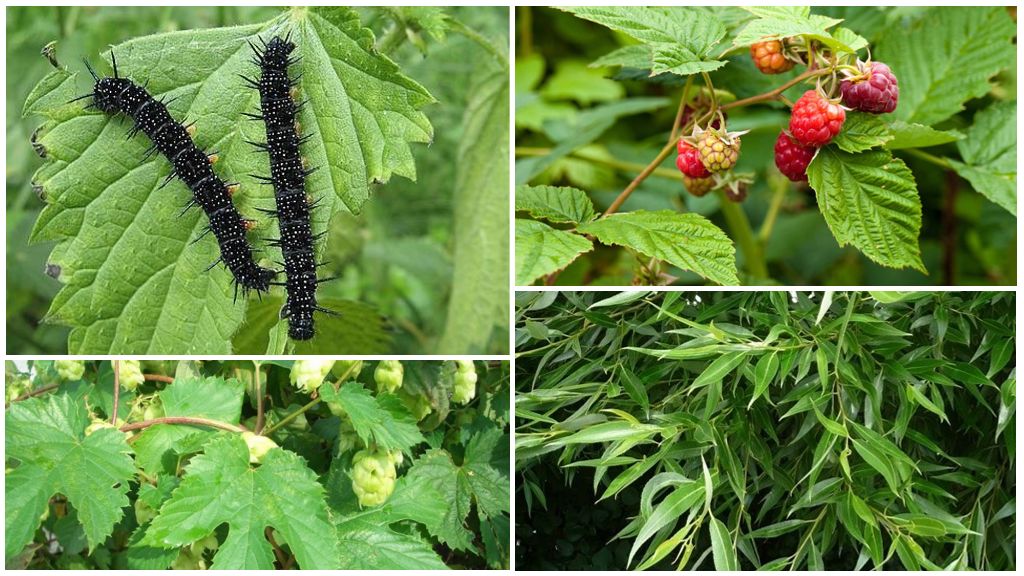
The butterfly caterpillar of the peacock eye develops under favorable conditions for 4 weeks. Because the butterfly lays eggs on nettles, caterpillars feed most often the leaves of this plant. They live in groups, but spread throughout the plant. Less commonly, the larva moves to other plants:
- willow;
- raspberries;
- common hops;
- hemp.
At the last stage, the peacock eye caterpillar turns into a chrysalis. At this stage, development lasts up to 2 weeks. Depending on which part of the plant — the leaf or stem — is attached to the pupa, the color changes. In the first case, greenish. In the second - brown.
Inside, complex processes take place, as a result of which one of the most beautiful butterflies on Earth appears from a black unpleasant larva.
Sabotage
The insect does not cause much harm at any stage of the life cycle.Peacock butterflies feed on plant nectars. Prefer burdock, thistle, thyme, scabiosis. They often sit on garden, decorative flowers, thereby contributing to pollination.
Caterpillars feed on nettle leaves, which also does not cause any particular inconvenience. The plant is ubiquitous in large numbers. And only if the caterpillars start up on raspberries, can a garden crop suffer with a strong infection.
On a note!
The peacock eye, despite its large numbers, needs protection, is listed in the Red Book.
Harmful relative
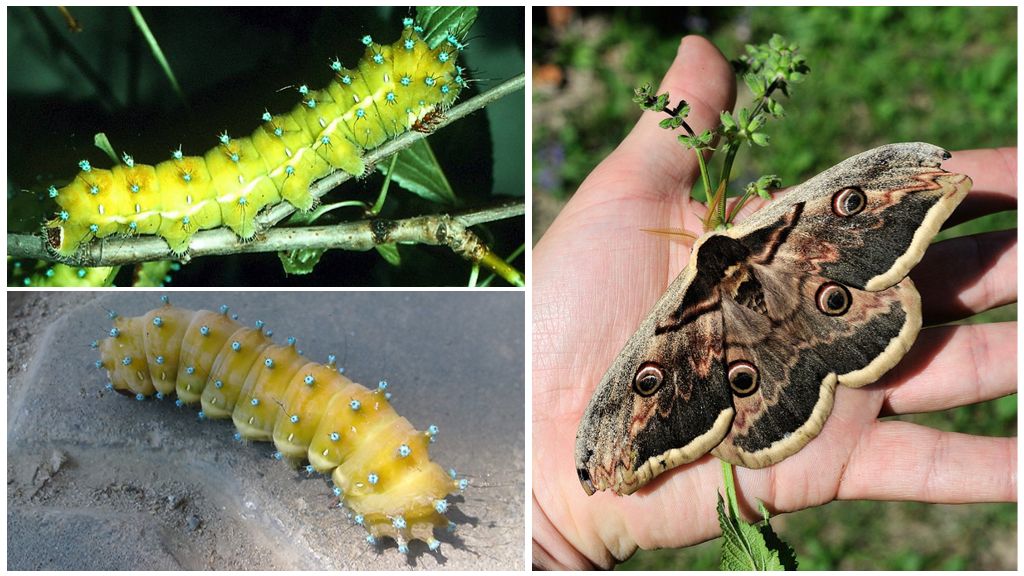
Peacock eye pear or large night peacock eye. Intensifies its activities at dusk. Outwardly, both the butterfly and the caterpillar are different. Large moth with wingspan up to 155 mm. The color scheme is white, brown, black. On wings a characteristic peephole.
Caterpillars develop from June to August. Large, green, body in blue warts, processes. The female lays eggs on fruit trees, after the birth of the larvae, they actively begin to feed, which causes irreparable damage. Despite this, the peacock-eye pear is also listed in the Red Book.
Pests hit the apple tree, pear, plum, walnut, cherry, blackthorn, rarely ash, elm. It harms trees with a large number of caterpillars. Winters in the pupal stage, sometimes twice, if adverse conditions prevented the butterfly from going outside.
Interesting!
Females are less mobile, their main task is to lay eggs up to 400 pieces at a time. Males are active even in the afternoon, are able to fly to the smell of pheromones of a female at a distance of 10 km. This opportunity is provided to females by a mustache, if they are torn off, the insect will remain helpless, will soon die.
Females live for about 20 days, at the end of their ability to reproduce eggs is minimized - 3 pieces at a time. Males live a short period - 8 days, die soon after fertilization.

